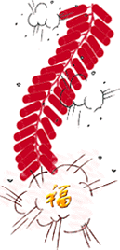|
The Spring Festival
()
Updated: 2004-01-16 15:45
 The Spring Festival, also known as "Guo Nian" or "the passing of the year," is China's oldest traditional festival. The fesival celebrates the new year of the Chinese Lunar Calendar. The lunar calendar's January 1 is "the beginning of the year, the beginning of the month and the beginning of the day." The celebrations last from New Year's Eve to the 15th day of the year's first lunar month, which is theLantern Festival. The Spring Festival, also known as "Guo Nian" or "the passing of the year," is China's oldest traditional festival. The fesival celebrates the new year of the Chinese Lunar Calendar. The lunar calendar's January 1 is "the beginning of the year, the beginning of the month and the beginning of the day." The celebrations last from New Year's Eve to the 15th day of the year's first lunar month, which is theLantern Festival.
People traditionally spend New Year's Eve at home with all the family around them. This often means a long journey for those who live away from the place they grew up or where their parents live. The family will celebrate with a sumptuous feast during which every member will join in toasting and giving each other New Year's blessings.
PapercutsDuring the Spring Festival, many families decorate their window panes with colourful and intricate papercuts portraying characters from Chinese opera, flowers, birds, insects and fish.
New Year's CoupletsNew Year's couplets, written on two strips of red paper, are an important custom of the Chinese Spring Festival. On the lunar New Year's Eve, families in both urban and rural areas make it a point to grace their gate posts or door panels with the couplets, composed of two sentences that complement each other and often rhyme expressing their hopes for the coming year.
New Year's PaintingsNew Year's paintings are a type of Chinese folk art that draws inspiration from the rural landscape and expresses traditional notions of what is important in life, such as prosperity and babies. During the Spring Festival, many Chinese people pin up a few New Year's paintings in their living rooms to bid farewell to the old year and greet the new.
Greeting CardsSending New Year's greeting cards to one's friends and family is yet another Chinese tradition. Sending the cards is a token of good will and is a useful way of keeping in touch with people one hasn't seen for a long time or who live far away.
 CandlesThroughout the Spring Festival, from the first day of the lunar new year to the Lantern Festival, as well as on other important days of the year, it is traditional for all Chinese people, whatever their ethnic origins, to light brightly-coloured candles as an expression of their joyful mood. CandlesThroughout the Spring Festival, from the first day of the lunar new year to the Lantern Festival, as well as on other important days of the year, it is traditional for all Chinese people, whatever their ethnic origins, to light brightly-coloured candles as an expression of their joyful mood.
Staying UpOn the lunar New Year's Eve, Chinese families gather for the reunion dinner. After eating, the whole family, including the children, stays up until after midnight or even all night to see the old year out and the new year in.
JiaoziJiaozi, or steamed dumplings, is a popular Chinese food. It is customary for people in north China to celebrate festivals by making and eating jiaozi. On New Year's Eve, the family gathers to prepare jiaozi, a time that is acknowledged as a fine opportunity to catch up on local gossip.
FirecrackersIt is traditional in China to celebrate the Spring Festival by letting off firecrackers or holding fireworks displays. As a result, the New Year's Eve night-sky is often a riot of colour and everyone is kept awake to enjoy the festivities by the noise of explosions all around.
|
